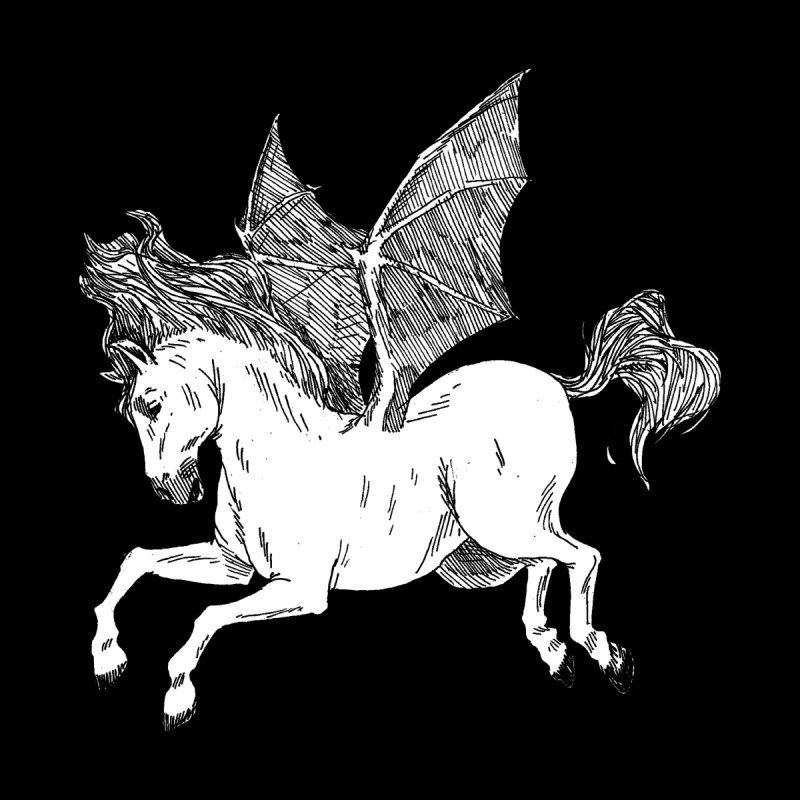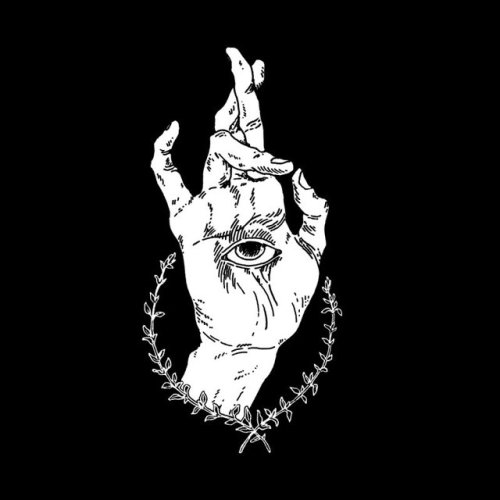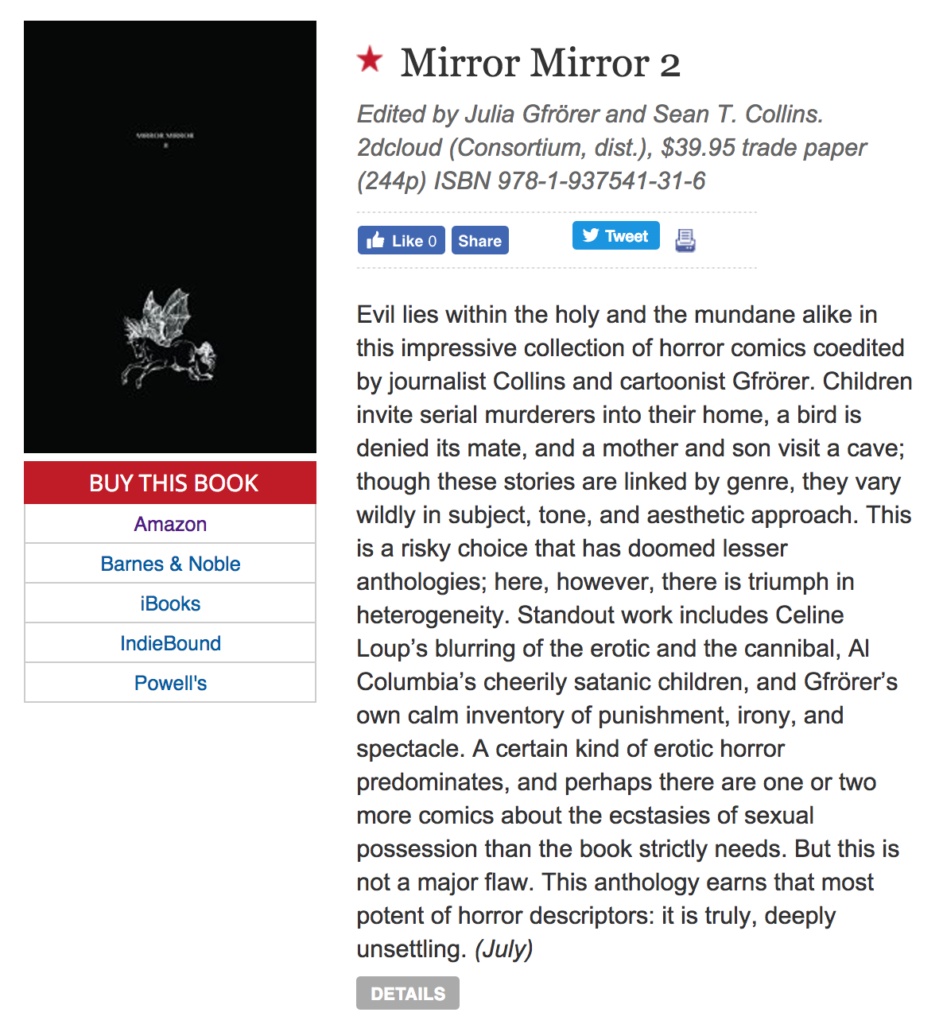Posts Tagged ‘horror’
31 October T-Shirts by Julia Gfrörer, Day 03: Night Mare
October 3, 201731 October T-Shirts by Julia Gfrörer, Day 02: Protective Hand
October 2, 2017MIRROR MIRROR II BOOK RELEASE PARTY @ DESERT ISLAND BROOKLYN
September 24, 2017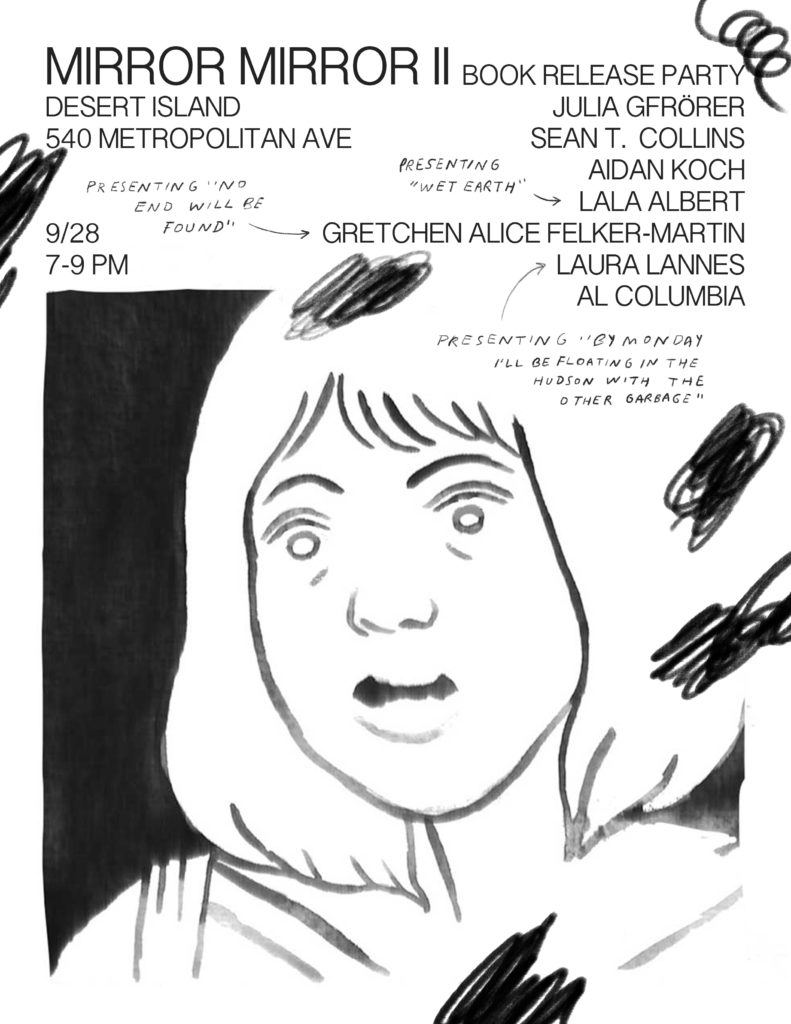
MIRROR MIRROR II
signing and book release party
Thursday, September 28th
7-9pm
Desert Island
540 Metropolitan Ave.
Brooklyn, NY
featuring
Lala Albert
Sean T. Collins
Al Columbia
Gretchen Alice Felker-Martin
Julia Gfrörer
Aidan Koch
Laura Lannes
Also debuting the latest new works from these authors:
-Wet Earth by Lala Albert | Sonatina
-By Monday I’ll Be Floating in the Hudson with the Other Garbage by Laura Lannes | 2dcloud
-No End Will Be Found by Gretchen Alice Felker-Martin | Thuban Press
poster by Laura Lannes
Harry Dean Stanton: 10 Essential Movies
September 18, 2017Twin Peaks: Fire Walk With Me (1992)
“I’ve already gone places. I just wanna stay where I am.” Stanton’s role as tired-looking trailer-park owner Carl Rodd in David Lynch’s Twin Peaks prequel was as cryptic as everything else in the film, lasting just a few short minutes and some spare lines of dialogue. But he packs decades of world-weariness into his brief screen time; nobody could turn “It’s just more shit I gotta do now” into a punchline that doubled as a declaration of existential despair. Stanton reprised and expanded the role in Peaks’ astonishing third season this year, cracking jokes about defying death one minute, bearing witness to unspeakable tragedy like an earthbound angel the next – a moving, bonus grace note in a long, legendary career. STC
Mirror Mirror II in PW
September 11, 2017“It”: Everything You Need to Know About Stephen King’s Killer Clown Story
September 11, 2017Pennywise is one of modern horror’s greatest monsters
He’s the original killer clown from outer space and the most infamous villain in Stephen King’s bibliography, which is saying something. (All apologies, Randall Flagg.) Pennywise the Dancing Clown is the form most frequently taken by a malevolent entity that’s been haunting the entire town of Derry, Maine for centuries; it’s lurked beneath the land since it hurtled through the cosmos and crash-landed on Earth from another dimension millennia ago. This shape-shifter can transform into its victims’ worst nightmares, feeding on both their fear and their flesh. Its preferred target: little kids, whose vivid imaginations give it an extensive menu of terrors to choose from. This also explains the monster’s default mode: What kid doesn’t love clowns? (At least before It more or less singlehandedly ruined their image, that is.)But in addition to being one mean, multifaceted predator, Pennywise has exerted a malign influence on the entire town. He himself – or It Itself – only emerges from hibernation once every 27 years or so for a feeding frenzy that lasts roughly a year to 18 months. But Its presence in the sewers beneath Derry radiates an evil that makes the small town the murder capital of New England … and generates a sort of willful amnesia among the population. Such forgetfulness keeps folks from reflecting on their sleepy burg’s history of atrocities, disasters and mass murders. It also prevents people from connecting the dots when the creature resurfaces and kids start going missing en masse.
Overall, Pennywise combines a killer look and set of powers with one of King’s strongest concepts: a fairy-tale troll that hides out not under a bridge, but an entire city – a ghost that haunts not just one house, but all of them. As our foremost chronicler of small-town American evil, King has a royally good time with the idea.
Why ‘Twin Peaks: The Return’ Was the Most Groundbreaking TV Series Ever
September 4, 2017A side note here: It feels goofy to praise David Lynch for not participating in the usual back-and-forth between showrunner and viewer about the need for answers, closure and a finale that “sticks the landing,” which the conclusions of The Sopranos and Lost have rendered a seemingly permanent part of the TV discourse. (It’s like giving Stanley Kubrick a shoutout for resisting the temptation to create the Kubrick Cinematic Universe.) Still, even if this wasn’t on the filmmaker’s mind, as seems likely, it certainly was on ours. How refreshing to watch a show wholly alien to the debates that consumed the final seasons of even the most truly wonderful dramas, from Mad Men to The Leftovers. And how cool to see a series so gloriously unsuited to the era TV takes, too. After “This is the water and this is the well,” didn’t every article you came across with a title like “Lucy Brennan Proves David Lynch Has a Receptionist Problem” or “Dr. Jacoby’s Spray-Painted Shit Shovels Would Work Much Better Using the Netflix Release Model” feel … a little small? Like, even smaller than usual?
[…]
Twin Peaks: The Return was a dazzling work of filmmaking. But unlike its jittering cameras, flashing lights, billowing smoke and ambient whooshing and whirring, its emotional foundations were rock solid. We may marvel at the cosmos Lynch and Frost created – a universe of vast purple oceans, towering metal fortresses, billowing red curtains and infinite fields of stars. We may spend another 25 years attempting to puzzle out Audrey’s location, the glass box’s bankroller, the true identity of “Judy” and what, exactly, became of the girl with the bug in her mouth. But there’s nothing ethereal or mysterious about abuse, trauma and the irresistible death-march of time. That part of Twin Peaks, the part that counts most, is as clear as your reflection in the mirror.
Twin Peaks is the best television show ever made. I tried to explain why for Rolling Stone.
“Twin Peaks” thoughts, Season Three, Episodes Seventeen and Eighteen
September 4, 2017So ends the con job that Lynch and Frost telegraphed from the season’s subtitle, The Return, on down. After all, the original Twin Peaks ended in the worst possible way: goodness corrupted, evil triumphant. Fire Walk With Me hinted at a way forward, only to linger on cruelty and suffering. Certainly nothing in Lynch’s intervening filmography indicated that this story would have a happy ending. Why wouldn’t we wind up right back where we started: an unspeakable violation, carving a hole in the moral fabric of the universe that no one, not even the whitest of knights, is capable of making whole?
This is Twin Peaks: The Return, alright. A return to pain that can’t be healed, crimes that can’t be solved, wrongs that can’t be righted. We drank full. We descended. There’s no way up and out again.
I reviewed the final episode of Twin Peaks Season Three for Rolling Stone.
“Game of Thrones” Director Jeremy Podeswa on Shooting That Gigantic Season Finale
August 30, 2017Beyond Sansa and Arya’s rapprochement, the episode ends with Dany and Jon’s love scene and the fall of the Wall.
Yeah. It’s what the whole show is talking about, really, and why there is a summit at the Dragonpit in the first place. The show is so much about people fighting for power and one-upmanship and control, but at the end of the day, it’s a metaphor for life. Whatever we try — to be rich, to be happy — death is unavoidable. It doesn’t matter how much money you have, it doesn’t matter how much love you have. At the end of the day, it’s all heading that way. It puts all this gamesmanship and fight for power in relief, and it’s a big part of what this show is about.
Coming so hot on the heels of the Jon and Dany scene, which was about life and love and all those powerful forces, I was really struck by the shot you did of the zombies just watching as the Night King and the dragon destroy the Wall. There was an awful sense of violation about that.
Something that Game of Thrones always does successfully is that action sequences are never just action sequences. There’s always a point of view, and you’re always identifying with one person or one group of people. I think in this case, it’s not that you identify with the White Walkers, but there is a strange consciousness among them. It’s not spectacle just for the sake of spectacle. There’s actually a human drama that’s being played out here, and in this case this is the implacable enemy. It’s the forces of death over the forces of life. You have to believe in them as a kind of real, living, breathing, sentient mass.
The way to create drama in a sequence like this is by making it about these figures, not just about a Wall coming down. It’s really about the forces of good versus evil, and evil has a face.
“Twin Peaks” thoughts, Season Three, Episode Sixteen
August 28, 2017With only one week and two hours remaining, this season/series revival had spent nearly its entire running time chronicling the (mis)adventures of a Coop far from the one we knew and loved all those years ago – and that’s not even counting the evil doppelganger who escaped the Black Lodge into our world. Our beloved federal agent may have finally escaped that zig-zagged hellscape, but he wound up trapped in the life of a Las Vegas insurance agent named Dougie Jones. Episode after episode, “Dougie” was unable to remember not just his past but, like, how to speak in complete sentences. Somehow, this didn’t prevent our hapless hero from surviving multiple assassination attempts, winning both the local mob bosses’ favor and thousands of dollars at the slots (“Hell-oooooooo!”), making sweet love to Naomi Watts and consuming his fair share of damn good coffee and cherry pie. It was as if his innate Coop-ness was still shining through, guiding him through life’s dangers even if he was incapable of figuring out how a door works.
Then, last week, something changed. Hearing the name of his old mentor Gordon Cole in the movie Sunset Boulevard, “Dougie” was somehow triggered into jabbing a fork into an electrical outlet, sending him into a coma. What emerges on the other side in this episode is wonderful even beyond the imagining of people who’ve waited for this moment for two decades and counting.
“You are awake,” says the one-armed man Philip Gerard in a vision.
“One-hundred percent,” says Dale – the real Dale – in response.
Welcome back, Cooper — the do-gooder, go-getter and wrong-righter whose decency shone like a beacon through all of the darkness all those years ago. The music that accompanies his awakening is the Twin Peaks theme itself. He even still loves and cares for Janey-E and Sonny Jim, the family you might have expected him to simply abandon. By the time his insurance-agency boss Battlin’ Bud Bushnell warns him the FBI is looking for him and he turns to the camera and says, “I am the FBI,” it’s hard to believe there was a single Peaks freak on the planet who wasn’t either screaming for joy or a blubbering mess.
I can count on one hand the number of times I’ve been as moved by an episode of television I was by last night’s Twin Peaks. Just openly sobbing with joy. I reviewed it for Rolling Stone.
“Twin Peaks” thoughts, Season Three, Episode Fifteen
August 21, 2017SPOILER ALERT
But the beating, breaking heart of the episode is undoubtedly the death of Margaret Lanterman, the prophetic Log Lady. During one of her regular phone calls to Deputy Hawk, she tells him, repeatedly, “I’m dying.” She seems to have as positive an outlook on it as possible, saying death is “just a change, not an end.” But this is all coming from the mouth of actor Catherine E. Coulson, who was herself actually dying when the scene was shot. “Hawk, my log is turning gold,” she says, her voice wavering. “The wind is moaning. I’m dying. Goodnight, Hawk.” “Goodnight, Margaret,” he says as they hang up. Then, after she’s gone, he mournfully repeats the phrase: “Goodbye, Margaret.” If you could make it past that point without bawling, you’re made of stronger stuff than most of us.
The Log Lady, Big Ed and Norma, Audrey, Steven and Gersten, the screaming woman at the Roadhouse: They’re all connected not just by geography, but by states of spiritual extremis. They experience enormous, nearly crippling feelings – all of which leave them questioning their place in life. Lynch and Frost still bring the bizarre in this hour. But they also carefully, respectfully depict deep, vulnerable emotional states and trust us to take them seriously. That makes all the difference.
The Quietus on Mirror Mirror II
August 20, 2017“The book is an eclectic mix, beautiful and unsettling, with a strong erotic element….Mirror Mirror II is an immensely strong book, full of varied, challenging work that will not disappoint fans of the featured genres. If you come across a copy, I highly recommend picking it up.”
Our book Mirror Mirror II has gotten another wonderful review, for which we are very grateful. You can buy the book from our publisher 2dcloud or Amazon.
Dean Hurley – Anthology Resource Vol. 1 △△
August 19, 2017You don’t have to pay attention to Anthology Resource Vol. 1 △△. In fact, I’d go so far as to make that an order: Do notpay attention to Anthology Resource. This album of ambient music and soundscapes from the astonishing third season of “Twin Peaks,” by the show’s music and sound supervisor Dean Hurley, will frustrate focused attempts at listening. Passages feel overlong and repetitive, despite 11 of the collection’s 18 compositions clocking in at two minutes or less. Moments of beauty and terror burst out of the murk, only to dissipate with aggravating speed. Hurley’s airy electronic tones conjure up a sense of space so distinct you can practically see it, as titles like “Weighted Room / Choral Swarm,” “Tube Wind Dream,” “Interior Home by the Sea,” and “Forest / Interior” make clear. Yet the effect of sitting and listening intently to song after song is like looking through a window at these strange new worlds, only for someone to abruptly close the blinds on you over and over.
Here’s the thing, though: So what?
I reviewed the first of this season’s Twin Peaks soundtrack/score albums, Dean Hurley’s Anthology Resource Vol. 1 △△, for Pitchfork. It’s a roundabout way for me to talk about Transcendental Meditation, too.
“Twin Peaks” thoughts, Season Three, Episode Fourteen
August 14, 2017The flipside to Andy’s stairway to heaven is Sarah Palmer’s ongoing descent into hell – a journey, it seems, that’s literal as well as psychological. When the matriarch is hit on by a barfly, it sounds as if she can barely get out the words to reject him: “Would you sit back where you were,” she she stammers. “Please.” He turns vulgar, and potentially violent, at which point actor Grace Zabriskie’s eyes go wide. Then Mrs. Palmer reaches up … and takes her own face off, revealing a void inhabited by snake-like tongue, a ghostly hand, and an enormous, terrible grin. “Do you really want to fuck with this?” growls her voice from within. She puts her face back on. And then she bites an enormous chunk out of her harasser’s neck. When the bartender comes over to see what happened, Sarah turns cold. “Sure is a mystery, huh?”
It’s a horrifying scene, and not just for the obvious reasons. The Black Lodge is not just a supernatural locus of darkness; it’s an opportunistic infection that enters our world where our boundaries are worn thin by all-too-human evil. A quarter of a century ago, Mrs. Palmer was helpless to stop her possessed husband from assaulting and killing her daughter Laura (and other young women too) before the entity inside him devoured the man in turn. How do you recover from that? The allegorical answer offered in this scene, and its vision of corruption beneath the surface, is that you don’t. The Lodge, which first used her as its mouthpiece during a scene you may have forgotten from the original series finale, has eaten her away from within. (And while it’s tempting to wish that Laura had her mother’s powers when facing any of the men who abused her, you should recall that the original series’ posthumous heroine chose death rather than allowing that kind of evil to inhabit her.)
I reviewed last night’s episode of Twin Peaks for Rolling Stone.
“Twin Peaks” thoughts, Season Three, Episode Thirteen
August 8, 2017What’s worse: Crushing a person’s skull or crushing their spirit? The back-from-the-dead Twin Peaks has seen its fair share of the former violation, courtesy of the supernaturally strong denizens of the Black Lodge. When those demonic entities are around – whether they’re Woodsmen assaulting radio-station employees or Dale Cooper‘s evil doppelganger shattering a rival criminal’s face with a single punch after an arm-wrestling bout – no cranium is safe. And then there’s the long, wordless scene starring Big Ed Hurley (Everett McGill, making his revival debut), which features no monsters and no murders – but as the credits roll over his sad and lonesome face, didn’t your brain feel under assault?
It’s not as if co-creator/director David Lynch is new to depicting the trials of growing up and getting old. You don’t need to look any farther afield than Twin Peaks‘ own Carl Rodd, played by Harry Dean Stanton, for a portrait of the weariness and wisdom that comes with that territory. (Stanton’s wordless appearance in the filmmaker’s 1999 movie The Straight Story is quietly devastating for the same reason.) Moreover, the visible effects of aging on actors such as Dana Ashbrook (Bobby Briggs), James Marshall (James Hurley), Michael Horse (Deputy Hawk), etc. were enough to take the breath away from any fan who remembered them primarily in their youthful, brown-haired heyday. It’s not that they looked bad, by any means – just that the lines in the face and the gray in their hair, or in James’ case the absence of hair altogether, remind you that you, too, have aged 25 years since our last visit to this sleepy, sinister town.
But Big Ed’s return is especially gutting. While at first it appears he’s together with Norma Jennings, the love of his life, at last, it turns out they’re now just friends; she’s actually seeing a corporate suit who’s helped her turn the Double R diner into a franchise. He still wears his wedding ring, but it’s unclear if he’s still together with his one-eyed wife Nadine; at any rate, she seems far more interested in Dr. Jacobyand his goofball anti-government, anti-capitalist screeds. Even Ed’s “Gas Farm” seems to be dying out from lack of business. So we’re left with a vision of this man alone at night, joylessly sipping soup – or is that garmonbozia? – from a Double R take-out cup and idly lighting fires that burn down to his fingers. With his high cheekbones and severe haircut, McGill gives the impression of a childless King Lear, surveying a kingdom of rust with no heirs to claim it.
I reviewed last night’s Twin Peaks for Rolling Stone. The Big Ed scene is one of the most powerful and memorable things Lynch has ever shot, full stop.
The Top 30 Stephen King Movies, Ranked
August 3, 20173. The Dead Zone (1983)
David Cronenberg is the man who made “body horror” a thing; Stephen King’s tales of terror derive much of their power from down-to-earth Americana. An odd couple, to be sure. But the Canadian auteur brings out the best in the story of a New England schoolteacher (professional weirdo Christopher Walken, pitch-perfect) who awakens from a five-year coma with the ability to see the future of anyone he touches. Co-starring Martin Sheen as a blustery, right-wing politician rising to power via blue-collar populism and ready to trigger World War III – imagine that! It’s cerebral but not chilly, complex but compelling – and as eerily prescient as its psychic protagonist. STC
I wrote about The Dead Zone for Rolling Stone’s very gutsy ranking of Stephen King movie adaptations. The Top 10 is going to throw you for a loop.
“Twin Peaks” thoughts, Season Three, Episode Twelve
July 31, 2017As played by Grace Zabriskie, who is still utterly mesmerizing in the role, Sarah Palmer looks and acts like her daughter Laura’s murder incinerated her spirit and sanity for good. Staggering through the supermarket to pick up vodka and cigarettes, she has a panic attack at the checkout line, triggered by new items behind the counter. Her dialogue, reminiscent of the screaming driver from last week’s episode, is a crescendo of terror. “The room seems different. And men are coming. I am trying to tell you that you have to watch out! Things can happen! Something happened to me! I don’t feel good. I don’t feel good!” By the time Deputy Hawk checks in on Sarah later that day, she’s no longer agitated, but her flat affect is even harder to behold.
We’ve all got stories, yes. But in Twin Peaks, as in life, some of those stories end long before the lives of their main characters, leaving a lifetime of blank pages to turn, one after another, before the book closes.
I reviewed last night’s Twin Peaks for Rolling Stone. I focused mostly on Audrey Horne’s unusual return and what such scenes say about the unseen stories of everyone’s life, but I wanted to share this concluding passage about Sarah Palmer.
“Twin Peaks” thoughts, Season Three, Episode Eleven
July 24, 2017It’s simply impossible to predict where this thing will go within any given scene, much less from one to the next. This wild blend of moods and styles draws you intothe resulting drama rather than pushing you out of it. It leaves you desperate to see what these black magicians will do next.
Take the extended sequence at the Double R Diner, featuring Deputy Bobby Briggs, his ex-wife Shelly and their wayward daughter Becky Burnett. It begins as a touching, gutting scene of family drama, in which the estranged couple try, gently but desperately, to help their girl escape her no-good husband Steven. His latest affair sent her rushing to the apartment of the other woman (Alicia Witt, reprising her brief role in the original series as Donna Hayward’s kid sister), guns blazing. It also left Shelly sprawled on the lawn of Carl Rodd‘s trailer park, when her attempt to stop the young woman by clinging to the hood of her own stolen car ended in failure.
The resulting performances are as sumptuous as one of Norma Jennings‘ cherry pies. In Bobby’s frustration with his shitheel son-in-law, actor Dana Ashbrook brings out flashes of the angry young man the character once was. As Becky, Amanda Seyfried is saucer-eyed wonder; her denial that her spouse beats her is as transparent as her parents’ need to believe it is heartbreaking – after all, Shelly herself was once in an abusive marriage. Mädchen Amick radiates the character’s older-but-wiser experience throughout the scene. Eventually, the trio reach an unspoken decision to pretend they’ve gotten somewhere and end the argument – a sensation familiar to anyone who’s repeatedly faced down the same interpersonal issue with no real results.
Suddenly, a familiar face appears in the window, rapidly approaching the diner: Red, the magic-wielding druglord whose taunting of Richard Horne sent the young sociopath on his fatal ride a few weeks ago. He’s also the former Mrs. Briggs’s new boyfriend, and she rushes out to neck with him like a teenager in love – leaving her actual one-time teenage lover Bobby looking like a sad puppy. Like her daughter, Shelly remains drawn to bad boys, even though it seems she has no idea how bad the boy really is.
No sooner does she sit back down than our false sense of security is shattered by gunshots. Rushing outside to confront the shooter, Bobby discovers neither hit men nor homicidal maniacs, but a furious mother in the middle of a traffic jam, berating her gun-nut husband for leaving a loaded weapon in the family car. Bobby stares at the kid who fired the shots – the boy’s “fuck you” demeanor is a miniature replica of his father’s – and winces at the cycle of macho idiocy already at work.
Meanwhile, the car behind the young gunman’s vehicle honks and honks. An older woman is furious about the traffic jam preventing her from getting home for dinner – and it’s clear something is wrong here. As her demeanor reaches white-hot panic, the woman bellows, “Her uncle is joining us! She hasn’t seen him in a very long while!” Wait – whose uncle? “We’re late! We’ve got miles to go! Please, we have to get home! She’s sick!” Then the horror begins: As the driver shrieks and shrieks, a girl rises up from the shadows of the passenger seat, arms outstretched like a zombie, green vomit leaking from her mouth. Then the sequence ends, its final moments chillingly unexplained.
I reviewed last night’s utterly marvelous Twin Peaks for Rolling Stone. I could have written four times as much about this diner sequence alone, but really any given scene from the episode could sustain a full review’s worth of analysis. The show is that good.
Mirror Mirror II
July 21, 2017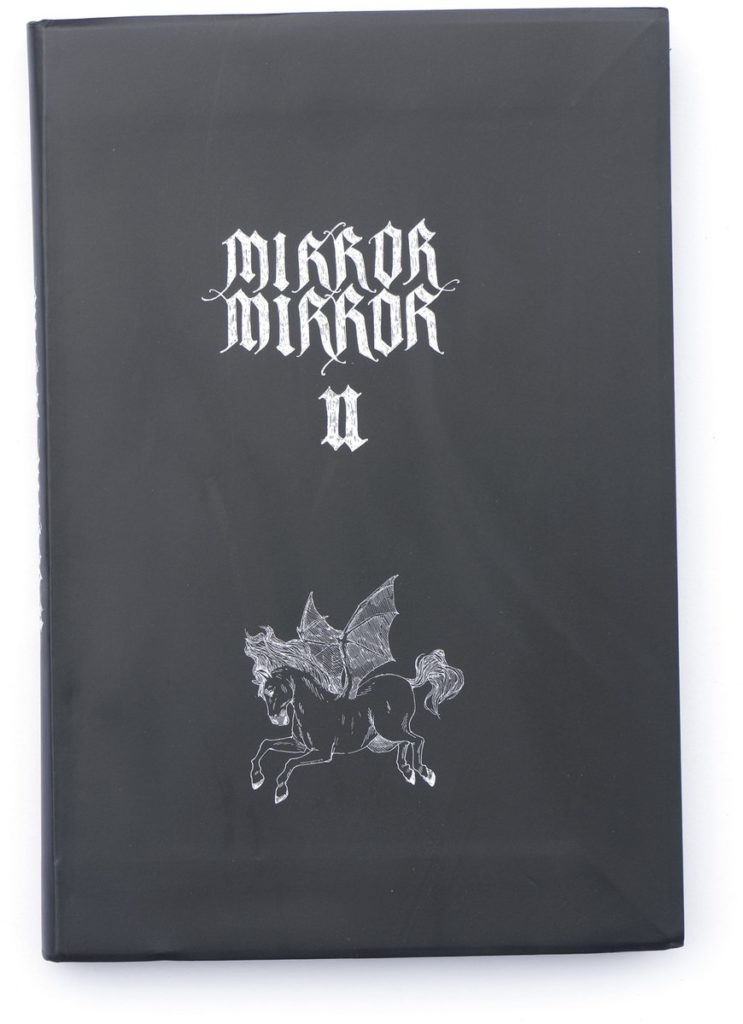
Our anthology Mirror Mirror II, edited by Julia Gfrörer and myself, is now officially for sale from our publisher, 2dcloud, and from our own webstore. Click here to order and see an extensive preview, or click here to buy it from Julia directly.
Contributors include Lala Albert, Clive Barker, Heather Benjamin, Apolo Cacho, Sean Christensen, Nicole Claveloux, Sean T. Collins, Al Columbia, Dame Darcy, Gretchen Alice Felker-Martin, Noel Freibert, Renee French, Meaghan Garvey, Julia Gfrörer, Simon Hanselmann, Aidan Koch, Laura Lannes, Céline Loup, Uno Moralez, Mou, Jonny Negron, Claude Paradin, Chloe Piene, Josh Simmons, Carol Swain, and Trungles.
Our contributors come from Australia, Brazil, England, France, Mexico, Russia, Wales, and the United States. The youngest is 24. The oldest is 77. The majority are women. They are trans and cis, straight and queer. They make comics, zines, fine art, music, film, literature, and journalism. For our book they made work basted around horror, pornography, the gothic, and the abject. They made dark, vulnerable work that reflects the dark, vulnerable world, in hopes that confronting it moves us toward empathy.
Here’s what people are saying about it:
One of the 10 Best Comics of 2017 – The Verge
One of the Best Comics of 2017 – The A.V. Club
One of the Best Comics of 2017 – The Beat
Starred Review – Publishers Weekly
Honorable Mention – The 2017 Publishers Weekly Graphic Novel Critics Poll
“This anthology earns that most potent of horror descriptors: it is truly, deeply unsettling.” —Publishers Weekly (starred review)
“This collection doesn’t just feel haunting; it feels corrosive.” —Juliet Kahn, The Verge, “The 10 Best Comics of 2017”
“Mirror Mirror II is troubling and challenging, but it is also rewarding and stunning—a thrilling experience that readers won’t soon forget.” —Shea Hennum, The A.V. Club, “The A.V. Club’s Favorite Comics of 2017 So Far”
“In a year that many have found bleak and depressing, Mirror Mirror II managed to channel this energy into one of the most riveting visual experiences of the year….the best horror comics anthology available.” —Phillippe Leblanc, “The Beat’s Best Comics of 2017”
“This book should win all the design awards for 2017. It’s as magnificent as the contents are (purposely) horrific.” —Heidi MacDonald, “The Beat’s Best Comics of 2017”
“It awakens the long-underused [horror] genre and pushes your fear buttons in ways you could never have anticipated. It’s hard to pick the most memorably mind-devouring portion.” —Abraham Riesman, Vulture, “8 Comics You Need to Read This June”
“Each comic or illustration feels like a peek into the mercurial depths of the individual artists, never just sex and horror for provocation’s sake. That honesty can be revealing for readers as well — when was the last time a horror/sex anthology taught you something about yourself?” —Jordan Darville, The Fader
“A sexy, creepy book which is daring in the topics it addresses…It does not shy away from how complex and difficult its subject matter is. It’s also a sumptuously designed, beautifully illustrated compendium of some of the most talented alternative comic creators working today.” —Tom Baker, Broken Frontier
“The book is an eclectic mix, beautiful and unsettling, with a strong erotic element….Mirror Mirror II is an immensely strong book, full of varied, challenging work that will not disappoint fans of the featured genres. If you come across a copy, I highly recommend picking it up.” —Pete Redrup, The Quietus
“Reading this is like dreaming — though whether you’re immersed in a nightmare or a wet dream is unclear….This book is like a porn stash you’d find in the cupboard of a medieval demon.” —Dan Schindel, Hyperallergic
“Mirror Mirror II is at once a frivolous memento mori and an outright challenge to your own personal space.” —Austin Lanari, Comics Bulletin
“At a time when real, human-rights-violating terrors abound, and the collective stomach is weak…Gfrörer and Collins see the genre as a processing mechanism to sort out repressed anxieties, echoing critics such as Robin Wood who has argued that the ‘horror genre is a struggle for recognition of all that our civilization represses or oppresses.'”—Minh Nguyen, AQNB
“I’m not going to lie, this one really messed with me. If I were listing comics that challenged me the most in 2017…this would have been number one with a bullet….Collins and Gfrörer push to the very edge without going over it, with stories that show the strong link between eroticism and horror. It’s really unlike anything I’ve ever read.” —Rob McGonigal, Panel Patter
“High quality smut.” —Will Menaker, Chapo Trap House
“Kind of feeling [it]” —Kevin Huizenga (Ganges), “Notable Comics Read in 2017”
“Early contender for best graphic novel of 2017.” —Philippe LeBlanc, The Beat
“This is a book that provokes, that pushes and pulls, that strips down to the bone and re-clothes in different flesh any notions you might have about horror, pornography, and abjection. It’s wonderful….I haven’t had a book challenge me this much in a long time.” —Sarah Miller, Sequentialist
“A thought-provoking, richly entertaining collection from some of the most exciting comic artists working today. A must read for fans of the horrific and perverse.” —Bryan Cogman, Game of Thrones
“An impressive collection of beautiful depictions of grotesque things and grotesque depictions of beautiful things.” —Alan Resnick, Unedited Footage of a Bear / This House Has People in It
“Editors Sean T. Collins and Julia Gfrörer have assembled an exquisitely creepy and seductive new collection of comics with Mirror Mirror II. From Uno Moralez’s pixelated noirs to Dame Darcy’s ornate Gothic ghost stories, the wide range of horror here is fantastic, as characters creep and fuck in the shadows of unimaginable darkness throughout. It’s certainly the perfect, freaky anthology for you, your lover, and all the demons in your mind.” —Hazel Cills, MTV News / Jezebel
“Mirror Mirror II invites the most innovative creators working in the form today and proves just how expansive the pornographic and gothic can be, encapsulating the pop cultural, fantastical, and realistic in one fell swoop.” —Rachel Davies, Rookie / The Comics Journal
‘It’ Star Sophia Lillis on ‘Shocking’ First Encounter With Pennywise, Remake Details
July 20, 2017This September, Lillis stars in director Andrés Muschietti’s highly anticipated adaptation of horror master Stephen King’s signature work, It. She plays Beverly Marsh, the sole female member of a close-knit gang of teen outcasts called the Loser’s Club. During one long, nightmarish summer, the Losers find themselves face to face with the child-murdering, shape-shifting entity that’s haunted their small town for centuries – a creature that most frequently takes the form of a sinister clown called Pennywise, played by Bill Skarsgård.
“We actually weren’t allowed to see him until our scenes, because we wanted the horror to be real,” Lillis recalls. “Everyone had different reactions, but all of us were like, ‘Wow, what did we get ourselves into?’ One look at him, and… you know, he’s a really scary clown that wants to kill us. I was a little bit shocked,” she laughs. “But then he went up to me afterwards and was like, ‘Hi, how’s things?’ He’s really nice, but I didn’t know how to react.”
Lillis had no such trouble connecting with her fellow Losers, who include Jaeden Lieberher as ringleader Bill Denbrough and Stranger Things’ Finn Wolfhard as class clown Richie Tozier. “I spent all my summer with them, so we got really close. We still keep in touch, send messages to each other.” That closeness helped Lillis connect with her own character. “I relate to Beverly – the way she deals with her emotions, and the way she was around the Losers. I felt that way around the actual actors.”
I wrote a little profile of Sophia Lillis, aka Beverly in the new IT movie, for Rolling Stone.


